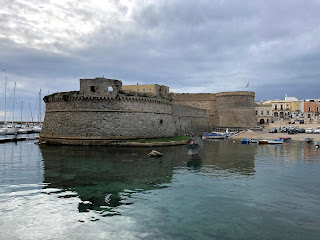With Coronavirus so much in the news, readers may wonder why we still chose to come to Italy. At the time there seemed little alternative. The cases were all in the north, and most remain 1000km away from us. Italy is a big country. Our only other options were to stay in Greece without knowing how long we might be there, or to face a very long drive back through Bulgaria and Romania. While Italy certainly has a high number of cases, and many people have sadly died, there are also more than a thousand cases in both France and Germany. Unless all the borders close, it would be easier to get home from here than it would be from Greece, and discovering new places is far preferable to retracing our steps.
 |
| The good news: signs of spring |
 |
| A moody day in Gallipoli |
 |
| Gallipoli looks brighter in the sun |
 |
| Taranto in elegant mood |
We pulled into a car park near the bus station and went for a short stroll. It was very quiet, rather run down, and the stray dogs were vocal and not in good condition. One bad review was enough to plant a seed of doubt in our minds, and we have long since agreed that if one of us isn't sure, then we move. So it was back in the van, and out to a shopping centre on the outskirts with parking for thousands of vehicles. Although it was private land there were no obvious prohibitions, and we spent a quiet night there. The morning brought our first encounter with the Happy Casa homewares store, and the exciting discovery that it was possible to buy a replacement cup and seal for my well used Bialetti coffee maker without having to replace the whole thing.
 |
| The Palazzo del Governo, Mussolini 1934 |
 |
| Last remains of the Greeks |
 |
| Street art in Taranto |
 |
| Lived in, but falling apart |
It was time for some cleaner air, and we headed inland for Matera, a place with its own colourful history, and its own problems, of which more next time. We had hoped to stay at a camper stop in the stunning hills of the nearby regional park, but it turned out to be government owned, and hence closed because of the coronavirus. A kind ranger allowed us to "carico e scarico" but we are again spending the night in car park, this time in designated motorhome bays in the centre of Matera. We shall explore tomorrow.
 |
| Elsa finds the smallest street in Taranto |
 |
| Best keep your tail out of that water |


Gosh what a lot to think about and consider. Not issues you could have dreamt up when planning your trip.
ReplyDeleteI’m left wondering after reading this blog, if after the beauty of Greece you are a little disappointed with your first days in Italy? Safe travels x